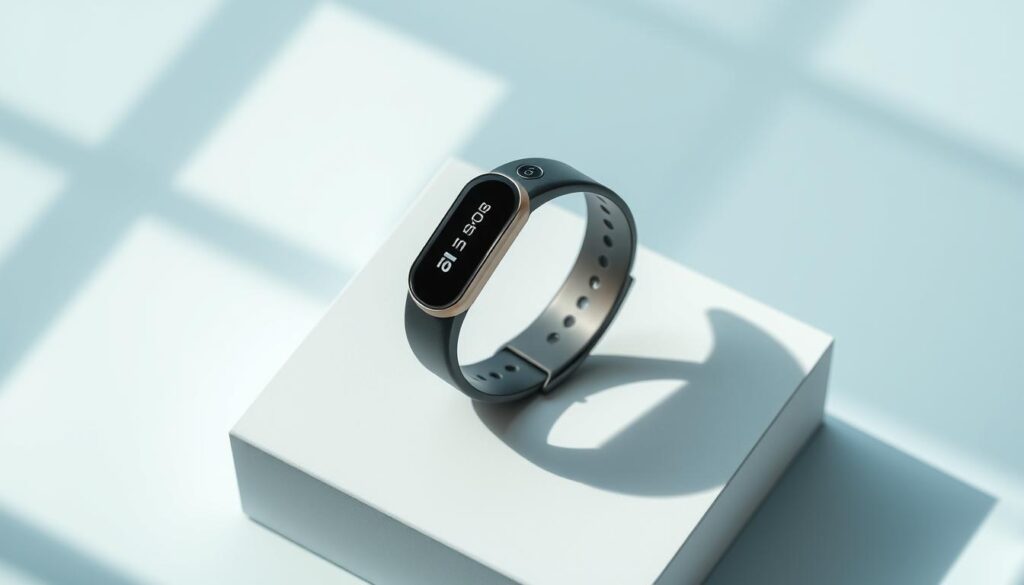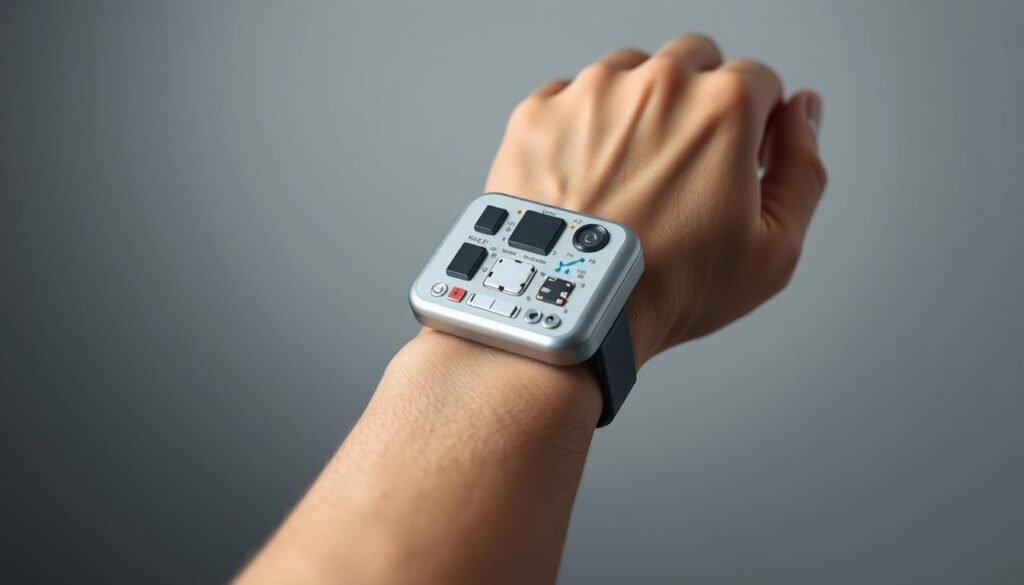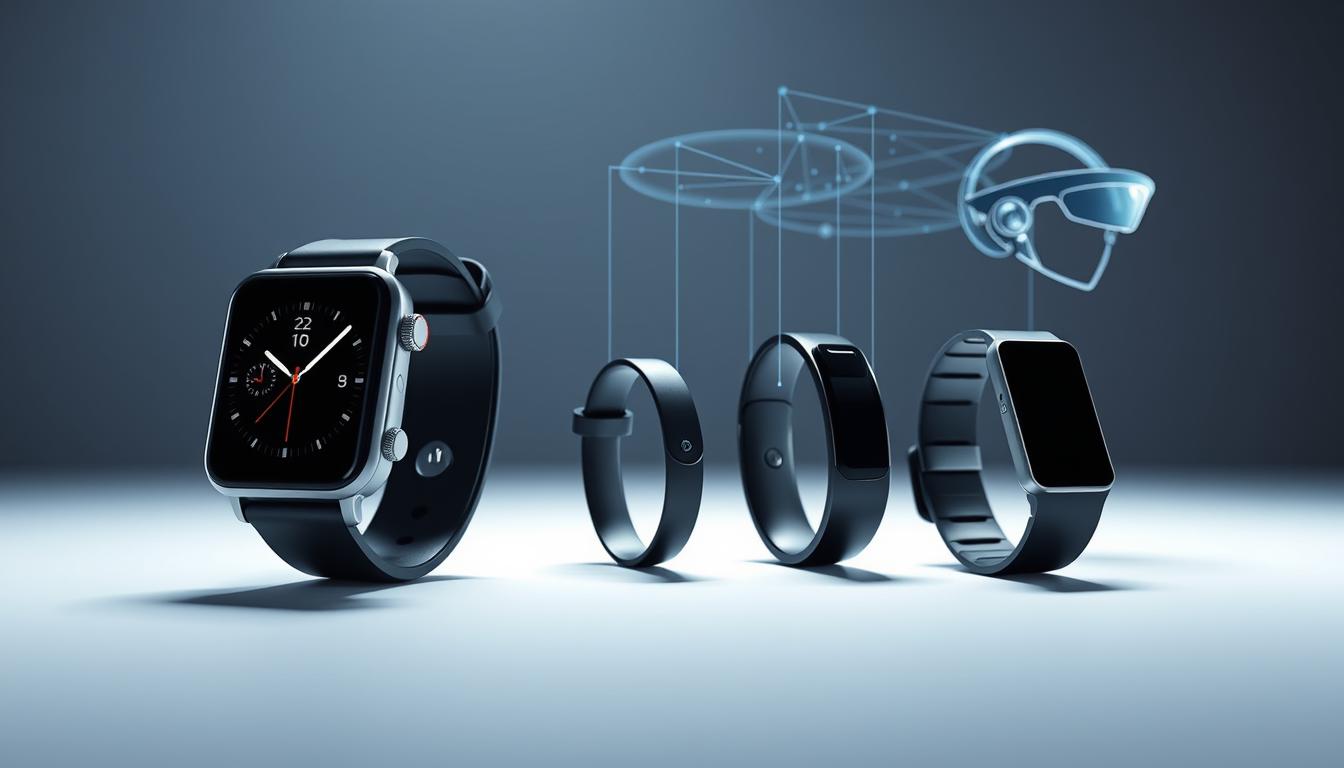Did you know that over 45,000 participants joined the MyHeart Counts app study within just six months of its launch in 20151? This highlights the growing interest in wearable devices that go beyond basic fitness tracking to offer comprehensive health monitoring. Today, wearable technology is transforming how we manage our health, with devices like the Apple Watch and Oura Ring leading the charge.
These advanced devices now monitor a wide range of health metrics, from heart rate and sleep quality to physical activity levels. For instance, studies have shown that wearable-derived sleep quality measures can moderately correlate with sleep disturbance scores in adolescents with asthma2. Moreover, interventions through apps like MyHeart Counts have significantly increased daily step counts, demonstrating the potential of wearables in improving physical activity levels1.
The evolution of wearable technology is not just about tracking data; it’s about enabling better health outcomes. Research by Professor Allan Lawrie aims to use wearable technology to collect heart rate and activity data from patients with pulmonary hypertension, potentially improving their care1. This shift underscores how wearables are becoming essential tools in both personal health management and clinical research.
Key Takeaways
- Wearable devices have expanded beyond fitness tracking to comprehensive health monitoring.
- Studies show wearables can effectively monitor sleep quality and physical activity.
- Apps like MyHeart Counts have proven to increase physical activity levels.
- Research using wearable data aims to improve outcomes for patients with conditions like pulmonary hypertension.
- The integration of wearable data into clinical practice could revolutionize healthcare.
Introduction to Wearable Wellness and Its Impact on Health
Wearable wellness refers to the use of portable devices that monitor and track various aspects of an individual’s health. These devices, equipped with advanced sensors, provide real-time health information that can significantly improve care and overall well-being.
At the heart of wearable wellness is the ability to collect and analyze data continuously. Sensors in these devices monitor metrics such as heart rate, sleep patterns, and physical activity. This real-time monitoring allows individuals and clinicians to make informed decisions, ensuring timely interventions and personalized care.
The integration of wearable data into clinical settings offers numerous benefits. For instance, heart rate monitoring can detect early signs of cardiac issues, while sleep trend analysis can help manage chronic conditions like insomnia. These insights enable healthcare providers to deliver more precise and effective care.
Moreover, wearable wellness empowers individuals to take charge of their health. By tracking daily metrics, users can identify trends and make lifestyle adjustments. For example, monitoring physical activity levels can encourage more active lifestyles, while sleep tracking can improve the quality of rest.
Research has shown that wearable devices can significantly impact both personal and clinical decision-making. Studies indicate that continuous monitoring can lead to better health outcomes, particularly in managing chronic diseases3. This underscores the transformative potential of wearable wellness in modern healthcare.
The Evolution of Wearable Technology in Healthcare
The journey of wearable technology in healthcare began with simple fitness trackers that monitored steps and heart rate. Over time, these devices evolved into sophisticated tools capable of advanced health monitoring.
Early wearable devices focused on basic activity tracking, but advancements in sensors and research have transformed them into essential medical instruments. For instance, the MyHeart Counts app study engaged over 45,000 participants in just six months, demonstrating the potential of wearables in clinical research4.
Today, devices like the Apple Watch and Oura Ring offer comprehensive health insights, from sleep quality to physical activity levels. Studies have shown that wearable-derived sleep quality measures can moderately correlate with sleep disturbance scores in adolescents with asthma5.
These innovations highlight the transition from consumer gadgets to clinical tools. Wearable technology now plays a crucial role in detecting early signs of cardiac issues and managing chronic conditions like insomnia. The integration of wearable data into clinical practice is revolutionizing healthcare by enabling early detection and timely interventions.
Integrating Devices Into Daily Health Routines
Smart devices have become essential tools in managing daily health routines, offering a seamless way to monitor and improve well-being. These devices integrate effortlessly into users’ lives, providing real-time insights that encourage positive behavior changes. For instance, apps like MyHeart Counts have proven to increase physical activity levels significantly6.
One of the key advantages of these devices is their ability to prompt interventions through reminders or activity challenges. This proactive approach helps users stay on track with their health goals. Moreover, the user-friendly design of these tools enhances engagement, making it easier for individuals to maintain consistent monitoring and intervention7.
Success stories from both consumer and clinical settings highlight the effectiveness of device integration. In clinical environments, wearables enable remote patient monitoring, reducing the need for frequent clinic visits and improving self-care practices6. For consumers, features like step challenges and achievement badges foster a sense of community, motivating users to stay active and healthy7.
Modern Health Monitoring: Beyond Fitness Tracking
Modern health monitoring has evolved significantly, moving beyond basic fitness tracking to offer comprehensive insights into personal and clinical health metrics. This transition is driven by advanced sensors and real-time data analytics, enabling more accurate and personalized health insights.
Advanced Sensors and Real-Time Data
Today’s wearable devices are equipped with sophisticated sensors that continuously monitor vital signs such as heart rate, blood oxygen levels, and sleep patterns. These sensors provide real-time data, which is crucial for managing conditions like atrial fibrillation8. For instance, ECG monitors in smartwatches can detect irregular heartbeats, offering life-saving insights for individuals with cardiac conditions8.
From Personal Activity to Clinical Metrics
Wearable devices now capture a wide range of data, from physical activity levels to clinical metrics. This integration allows for a more holistic approach to health monitoring. For example, continuous glucose monitors provide real-time blood sugar readings, aiding individuals with diabetes in managing their condition effectively8. Sleep tracking functionalities also offer insights into rest quality, which is essential for overall well-being.
| Feature | Example | Benefit |
|---|---|---|
| Heart Rate Monitoring | ECG Monitors | Detects arrhythmias and irregular heartbeats |
| Sleep Tracking | Advanced Sensors | Provides insights into sleep quality and duration |
| Physical Activity Tracking | Accelerometers | Monitors movement and exercise levels |
As highlighted by a recent study, “Real-time data from wearables can improve patient outcomes by enabling healthcare providers to make data-driven decisions”8. This underscores the importance of advanced sensors and continuous monitoring in modern health care.
Real-Time Data and Its Role in Clinical Decision Making
Real-time data from wearable devices has become a cornerstone in modern clinical decision-making. By providing continuous insights, these devices enable healthcare professionals to make timely and informed decisions, leading to better patient outcomes. Approximately 60% of healthcare professionals believe that timely information leads to better patient outcomes9.
The shift from static, snapshot data to continuous monitoring has revolutionized patient care. Real-time data allows clinicians to detect early signs of complications, such as irregular heartbeats or changes in physical activity levels. This proactive approach can reduce complications by over 30%9, ensuring interventions are made before conditions escalate.
- Real-time data aids in predicting disease progression and customizing treatment plans.
- It enhances decision-making by providing actionable insights, such as identifying high-risk patients through predictive modeling.
- Long-term monitoring offers a comprehensive view of patient health, improving the accuracy of clinical decisions.
“Real-time data from wearables can improve patient outcomes by enabling healthcare providers to make data-driven decisions.”
Challenges include integrating vast amounts of data into clinical workflows and ensuring patient privacy. However, the benefits, such as a 25% reduction in hospital readmission rates9, make real-time monitoring invaluable in modern healthcare.
Wearable Wellness: Harnessing Technology for Better Health Habits
The integration of wearable technology into daily routines is revolutionizing how individuals approach personal health. By providing real-time insights, these devices empower users to make informed decisions, fostering healthier habits and lifestyles. Studies indicate that users of wearable fitness devices increased their physical activity levels by an average of 30% compared to non-users10.
One of the key benefits of wearable technology is its ability to seamlessly integrate into daily life. Approximately 50% of consumers reported using a fitness tracker or smartwatch to monitor their health in 202210. These devices not only track physical activity but also monitor sleep quality, heart rate, and other vital signs, offering a holistic view of health. For instance, sleep tracking can identify patterns that may indicate underlying health issues, allowing for early interventions.
| Feature | Example | Benefit |
|---|---|---|
| Physical Activity Tracking | Smartwatches | Encourages increased movement and exercise |
| Sleep Monitoring | Advanced Sensors | Improves rest quality and duration |
| Heart Rate Monitoring | ECG Monitors | Detects irregular heartbeats and arrhythmias |
Moreover, wearable technology facilitates personalized health improvements by providing tailored recommendations. 70% of health and wellness app users reported that these applications helped them achieve their health goals more effectively10. This personalized approach ensures that users receive relevant guidance, enhancing the likelihood of sustained behavior change.
“Real-time data from wearables can improve patient outcomes by enabling healthcare providers to make data-driven decisions.”
In summary, wearable technology is reshaping personal health habits by offering real-time insights and personalized recommendations. With evidence from clinical trials and consumer trends, it’s clear that these devices empower individuals to adopt healthier lifestyles, leading to improved overall well-being.

Case Studies and Research Insights from Clinical Trials
Real-world applications of wearable devices in clinical research demonstrate their transformative potential. Two notable studies highlight how these technologies are reshaping healthcare.
MyHeart Counts App Study Highlights
The MyHeart Counts app study enrolled over 45,000 participants within six months of its launch in 201511. This study demonstrated the effectiveness of wearable devices in monitoring physical activity and heart rate. Participants showed a significant increase in daily step counts, proving the app’s ability to encourage physical activity11.
Personalized interventions played a crucial role in this study. By providing tailored feedback, the app helped participants improve their health metrics, showcasing the potential of wearables in clinical research11.
Lawrie’s Research on Pulmonary Hypertension
Professor Allan Lawrie’s research focuses on using wearable sensors to monitor patients with pulmonary hypertension. These devices track heart rate and physical activity, aiding in early diagnosis and personalized treatment plans11.
The study revealed a strong association between physical activity levels and symptom duration in patients. Higher activity levels correlated with shorter symptom duration, emphasizing the role of wearables in managing chronic conditions11.
| Feature | Example | Benefit |
|---|---|---|
| Heart Rate Monitoring | Smartwatches | Detects irregular heartbeats and monitors cardiac health |
| Physical Activity Tracking | Fitbit | Encourages movement and exercise, improving overall health |
| Early Diagnosis | Wearable Sensors | Identifies conditions like pulmonary hypertension early |
These case studies illustrate how wearable technology adds value to clinical research, enabling better patient outcomes and more effective treatments.
Wearable Technology in Employee Wellness and HR Settings
Wearable technology is revolutionizing employee wellness programs, offering innovative solutions to combat burnout and enhance engagement. By integrating real-time data, these devices provide insights that foster a healthier and more productive work environment.
Strategies for Burnout Prevention
Employers are leveraging wearable devices to monitor stress levels and physical activity, enabling early interventions. For instance, companies like Amazon saw a 30% decrease in healthcare claim costs after implementing wearables12. These tools allow HR professionals to identify at-risk employees and provide personalized support, promoting a proactive approach to mental health.
Enhancing Employee Engagement Through Data
Data from wearables empowers employees to take charge of their well-being. IBM reported a 30% increase in physical activity participation after introducing Fitbit rewards13. This engagement fosters a sense of community and motivation, driving healthier lifestyles and reducing burnout.
Integrated systems offer a holistic view of employee health, combining stress monitoring with activity tracking. Such approaches have led to a 25% reduction in health-related costs for organizations using fitness trackers12. The data-driven insights enable HR to make informed decisions, enhancing overall wellness programs.
Examples of feedback loops include personalized recommendations based on activity levels, encouraging employees to stay active. This not only boosts engagement but also demonstrates organizational care, leading to better job satisfaction and retention.
By adopting wearable technology, companies achieve significant benefits, including improved productivity and reduced healthcare costs. These data-driven strategies are reshaping how organizations approach employee wellness, ensuring a healthier and more engaged workforce.
Harnessing Wearable Sensors for Continuous Monitoring
Wearable devices equipped with advanced sensors are revolutionizing the way we monitor vital health metrics. These sensors continuously track heart rate, physical activity, and sleep quality, providing valuable insights for proactive health management.
Tracking Heart Rate and Physical Activity
Modern wearable sensors use photoplethysmography (PPG) to monitor heart rate continuously. This technology has been validated in studies, showing high accuracy compared to standard ECG measurements14. Physical activity tracking is enhanced through accelerometers, which measure movement and provide detailed insights into exercise levels.
Sleep, Recovery, and Stress Metrics
Sleep tracking in wearables uses a combination of accelerometer and heart rate data to assess sleep quality and duration. This data helps identify patterns linked to stress and recovery. For example, irregular sleep schedules can indicate stress, while consistent sleep patterns may suggest better recovery15.
| Feature | Example | Benefit |
|---|---|---|
| Heart Rate Monitoring | Smartwatches | Detects irregular heartbeats and monitors cardiac health |
| Physical Activity Tracking | Fitbit | Encourages movement and exercise, improving overall health |
| Sleep Tracking | Oura Ring | Provides insights into rest quality and duration |
Continuous data collection from these sensors supports timely health interventions. For instance, detecting abnormal heart rate patterns can lead to early diagnosis and treatment16. This proactive approach enhances overall well-being and reduces the risk of complications.

Personalized Health Interventions and Recommendations
Personalized health interventions are transforming the way healthcare is delivered, offering tailored recommendations based on individual data. This approach ensures that each person receives the most effective treatment plan for their unique needs.
The process begins with collecting data from wearable devices, which is then analyzed to create personalized interventions. For example, real-time data from wearables can lead to timely interventions, improving patient outcomes17.
Apps play a crucial role in delivering these tailored recommendations. They provide users with specific advice, such as exercise routines or dietary changes, based on their data. This personalized approach has been shown to enhance engagement and adherence to health programs18.
Tracking individual progress is essential. Continuous monitoring allows for adjustments in interventions, ensuring optimal outcomes. This data-driven approach emphasizes the importance of personalized care plans in achieving sustained progress18.
Personalized interventions not only improve treatment outcomes but also empower individuals to take an active role in their health. By focusing on data-driven decisions, healthcare providers can deliver more precise and effective care, leading to better overall well-being.
Data Privacy, Security, and Ethical Considerations
Data privacy and security are critical in the context of wearable health devices, especially as they handle sensitive health information. The increasing use of these devices in biomedical research and clinical care has raised ethical concerns19. Current regulations like HIPAA play a vital role in governing the collection and use of health data, ensuring that protected health information (PHI) is safeguarded20.
Adhering to HIPAA and Data Regulations
HIPAA guidelines require covered entities, such as healthcare providers and plans, to implement strong security measures for electronic health information. This includes encryption, multi-factor authentication, and strict access controls21. Business associates, like wearable technology providers, must also protect PHI through contractual agreements. Non-covered entities, such as life insurers, are not directly subject to HIPAA but must still handle PHI responsibly20.
User Consent and Transparent Data Practices
Transparency is essential when handling sensitive information. Users must be clearly informed about how their data is collected, used, and shared. For instance, Fitbit faced legal action for allegedly selling personal data without consent, highlighting the importance of clear user agreements21. Ensuring that users understand and agree to data practices builds trust and accountability.
| Regulation | Requirement | Benefit |
|---|---|---|
| HIPAA Privacy Rule | Grants rights over health information | Ensures patient control over their data |
| HIPAA Security Rule | Requires security for electronic PHI | Protects against data breaches |
| User Consent | Clear data usage agreements | Builds user trust and accountability |
Best practices include regular cybersecurity audits and clear communication with users about data practices. These measures are crucial for maintaining trust and ensuring compliance with evolving regulations2021.
Integration Challenges and the Future of Wearable Healthcare
As wearable devices become more prevalent in healthcare, integrating their data into existing clinical systems presents significant challenges. Despite their potential, issues like interoperability and data accuracy must be addressed to fully realize their benefits.
Technical Integration and Interoperability
One major hurdle is integrating wearable data with existing health IT systems. Many devices from different manufacturers operate on separate platforms, making it difficult for healthcare providers to access and utilize the data cohesively. For instance, while over 400 EHR-compatible wearables are available, ensuring seamless integration remains a challenge22.
Interoperability issues can be mitigated through standardized data formats and APIs. Epic, Cerner, and Meditech, leading EHR vendors, are working to connect wearable data, with Epic supporting connections from Fitbit and HealthKit22. This integration is crucial for maintaining data consistency and patient trust.
Predictive Analytics and AI Advancements
Predictive analytics and AI are enhancing the capabilities of wearable devices. By analyzing continuous data, these technologies can predict health issues before they become severe. For example, wearables can detect early signs of atrial fibrillation and COVID-19, showcasing their predictive potential19.
AI-driven insights help healthcare providers make informed decisions. However, challenges like data overload and alert fatigue must be managed through improved algorithms and user-friendly interfaces22.
Emerging trends suggest that wearable technology will continue to evolve, with advancements in battery life and connectivity enabling uninterrupted monitoring19. These innovations, combined with AI, promise to revolutionize healthcare delivery and improve patient outcomes significantly.
Expanding Applications: From Smart Clothing to Digital Health Implants
The field of wearable devices is expanding rapidly, with innovations now moving beyond traditional wrist-worn devices. Recent advancements have introduced smart clothing and digital health implants, offering new ways to monitor and manage health.
Innovations in Smart Health Apparel
Smart clothing is emerging as a comfortable and effective way to monitor vital signs. Sensors embedded in fabrics can track heart rate, breathing, and even detect irregular rhythms during activities like jogging23. For example, ECG measurement during sleep and exercise has shown promising results, making continuous health monitoring seamless and unobtrusive23.
These innovations are particularly beneficial for individuals who need constant monitoring without the bulk of traditional devices. By integrating sensors into everyday apparel, users can maintain their lifestyle while staying connected to their health data.
Biosensors and Implantable Devices
Biosensors and implantable devices are revolutionizing chronic disease management. These devices can detect early signs of conditions like atrial fibrillation and predict seizures with high accuracy23. Recent developments in the last year have shown that implantable sensors can reduce the risk of sudden complications in epilepsy by providing real-time alerts24.
Implantable devices also play a role in managing heart conditions. For instance, certain wearables have demonstrated feasibility in detecting atrial fibrillation, offering early interventions that can prevent serious health issues23.
| Feature | Example | Benefit |
|---|---|---|
| ECG Measurement | Smart T-Shirts | Provides quality comparable to Holter recordings |
| Seizure Prediction | Biosensors | High sensitivity and specificity in detection |
| Comfortable Monitoring | Smart Apparel | Seamless integration into daily life |
These advancements highlight the transformative potential of next-generation wearable technology in healthcare, offering personalized and effective health management solutions.
User Experience and Data-Driven Health Decisions
A seamless user experience is crucial for wearable devices, as it directly impacts how individuals engage with their health data. Intuitive app designs and interactive dashboards play a vital role in transforming raw information into actionable insights, enabling users to make informed health decisions. For instance, smart sensors in wearables track heart rate, sleep patterns, and activity levels, providing businesses with continuous data on consumer behavior25.
Features like progress tracking and data interpretation are essential for an excellent user experience. Interactive dashboards allow users to monitor their health metrics effortlessly, while features such as step challenges and achievement badges encourage consistent engagement. This proactive approach has been shown to drive healthier choices, potentially increasing demand for wellness products25.
| Feature | Example | Benefit |
|---|---|---|
| Intuitive Design | Interactive Dashboards | Facilitates easy data interpretation |
| Progress Tracking | Activity Challenges | Encourages consistent engagement |
| Continuous Feedback | Smart Sensors | Provides real-time health insights |
Improved user experience enhances overall care and engagement. For example, companies leveraging wearable consumer insights can tailor their offerings based on actual consumer needs, enhancing customer satisfaction25. Continuous feedback from wearable trackers helps refine health strategies, making them more effective and personalized.
Conclusion
In conclusion, the integration of wearable devices has revolutionized personal and clinical health management, offering significant benefits that enhance the quality of life. Studies have shown that users of wearable fitness devices increased their physical activity levels by an average of 30%, leading to improved health outcomes26. The MyHeart Counts app study, which enrolled over 45,000 participants, demonstrated the effectiveness of wearables in encouraging physical activity and improving health metrics26.
Real-time data from wearables has become a cornerstone in modern clinical decision-making, enabling healthcare providers to deliver timely and accurate treatments. Continuous monitoring allows for the early detection of chronic conditions, facilitating proactive management and improving patient outcomes26. Additionally, wearable technology has empowered individuals to take charge of their health, with features like sleep tracking and heart rate monitoring providing valuable insights for making informed decisions.
Looking ahead, the future of wearable healthcare is promising, with advancements in AI and predictive analytics poised to drive innovation. These technologies will enable early detection of health issues and personalized treatment plans, further enhancing the quality of life for millions. As wearable technology continues to evolve, it is essential to integrate these advancements into everyday health routines, fostering a healthier and more engaged population.
FAQ
How do wearable devices monitor health in real-time?
What are the benefits of using wearable technology for health monitoring?
Can wearable devices aid in the treatment of chronic conditions?
How secure is the data collected by wearable devices?
What role do wearable sensors play in clinical decision-making?
How accurate are the health metrics tracked by wearable devices?
Can wearable technology be integrated with existing healthcare systems?
What are the latest trends in wearable health technology?
Source Links
- Harnessing the power of wearable technology for health – https://researchfeatures.com/harnessing-power-wearable-technology-health/
- Wearable Technology and How This Can Be Implemented into Clinical Practice – https://pmc.ncbi.nlm.nih.gov/articles/PMC7275133/
- How Wearable Technology Can Promote Health – International Association for Human Resources Information Management – https://www.ihrim.org/2023/08/how-wearable-technology-can-promote-health/
- Health At Hand: Evolution, Impact, & Future Of Wearable Devices | Wellable – https://www.wellable.co/blog/health-at-hand-evolution-impact-future-of-wearable-devices/
- The Future of Healthcare: Wearable Technology – https://drkumo.com/wearable-technology-the-future-of-healthcare/
- The Impact of Wearables on Healthcare: From Wrist to Wellness – Digital Salutem – https://digitalsalutem.com/the-impact-of-wearables-on-healthcare/
- Wearable Wellness: Health Techs Impact – https://www.medicoverhospitals.in/articles/wearable-wellness-tech-for-better-health
- Innovations in Wearable Technology for Remote Health Monitoring – https://www.asahitechnologies.com/blog/innovations-wearable-technology-remote-health-monitoring/
- Revolutionizing Patient Data: How Real-Time Health Monitoring and Analytics Transform Healthcare – https://moldstud.com/articles/p-transforming-healthcare-through-innovative-real-time-health-monitoring-and-advanced-analytics-for-enhanced-patient-data-management
- Harnessing Tech to Enhance Your Wellness Plan – BetterYou – https://www.betteryou.ai/harnessing-tech-to-enhance-your-wellness-plan/
- Wearables and Their Potential to Transform Health Management: A Step towards Sustainable Development Goal 3 – https://www.mdpi.com/2071-1050/16/5/1850
- How Can Wearable Technology Revolutionize Employee Health Wellness Programs? – https://psico-smart.com/en/blogs/blog-how-can-wearable-technology-revolutionize-employee-health-wellness-programs-184093
- Wearable Technology in the Workplace: Enhancing Employee Health Monitoring – https://vorecol.com/blogs/blog-wearable-technology-in-the-workplace-enhancing-employee-health-monitoring-178798
- Harnessing Wearables and Digital Technologies to Decode the Cardiovascular Exposome – https://pmc.ncbi.nlm.nih.gov/articles/PMC11545923/
- Harnessing Consumer Wearable Digital Biomarkers for Individualized Recognition of Postpartum Depression Using the All of Us Research Program Data Set: Cross-Sectional Study – https://mhealth.jmir.org/2024/1/e54622
- The Watch Is Ticking: A Five-Year Plan to Harness Wearable Health Tech – https://institute.global/insights/public-services/watch-ticking-five-year-plan-harness-wearable-health-tech
- Search | RTI Health Solutions – https://healthcare.rti.org/insights/personalized-healthcare-digital-technology
- Personalised Wellness: Harnessing Technology to Maximise Health Outcomes | Hupe – https://www.hupe.life/articles/personalised-wellness-harnessing-technology-to-maximise-health-outcomes
- Challenges and recommendations for wearable devices in digital health: Data quality, interoperability, health equity, fairness – https://pmc.ncbi.nlm.nih.gov/articles/PMC9931360/
- Balancing Medical Technology and Data Security in Healthcare – MII – https://www.michiganinstruments.com/2024/03/medical-technological-and-data-security-in-healthcare/
- HIPAA Compliance in Wearable Health Technology – https://healthcare.mindbowser.com/hipaa-compliance-in-wearable-health-technology/
- Wearable Health Technology and Electronic Health Record Integration: Scoping Review and Future Directions – https://mhealth.jmir.org/2019/9/e12861/
- The Recent Progress and Applications of Digital Technologies in Healthcare: A Review – https://pmc.ncbi.nlm.nih.gov/articles/PMC7732404/
- Artificial intelligence enhanced sensors – enabling technologies to next-generation healthcare and biomedical platform – Bioelectronic Medicine – https://bioelecmed.biomedcentral.com/articles/10.1186/s42234-023-00118-1
- From Screens to Sensors: How Wearable Tech is Revolutionizing Consumer Insights – Insight7 – AI Tool For Interview Analysis & Market Research – https://insight7.io/from-screens-to-sensors-how-wearable-tech-is-revolutionizing-consumer-insights/
- The Impact Of Wearable Technology In Healthcare – PEPID Pulse – https://blog.pepid.com/2024/06/07/impact-of-wearable-technology-on-patient-monitoring-in-the-medical-field/




